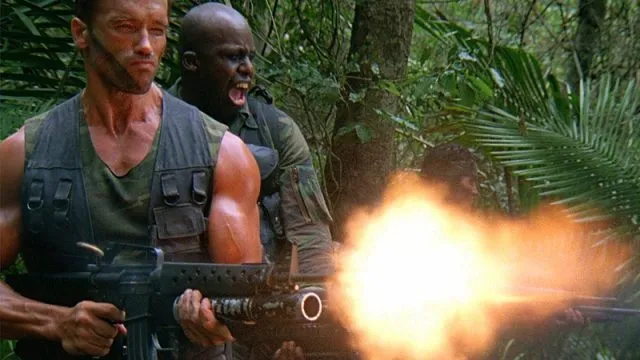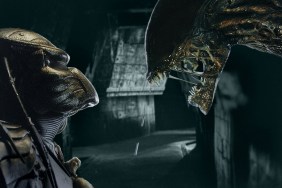Believe it or not, John McTiernan’s Predator blasted into theaters 35 years ago and went on to rip $98 million from the worldwide box office. Plus, it all but cemented Arnold Schwarzenegger — coming off the heels of The Terminator and Commando — as the de facto action star of the 1980s.
The premise is simple enough: a military rescue team led by Alan “Dutch” Schaefer (Schwarzenegger) — and consisting of Dillon (Carl Weathers), Mac (Bill Duke), Poncho (Richard Chaves), Blain (Jesse Ventura), Billy (Sonny Landham), and Hawkins (Shane Black) — does battle with a mysterious alien in the jungles of the fictional country Val Verde. After his crew is picked off one by one, Dutch must defeat the ugly hunter, or end up as a trophy on the creature’s belt.
RELATED: Prey Trailer & Poster Teases Hulu Release for Predator Prequel
Watching Predator again for the first time in quite a while, I was surprised at the low-budget quality of the production. The effects are rougher and less polished — a result of the on-location filming and the ostensible creature’s own clunky design — compared to other flicks released around the same time — films like RoboCop, Aliens, and Arnold’s own Total Recall, for example. Meanwhile, Donald McAlpine’s cinematography drenches the entire picture in darkness and rarely pulls back long enough to grant us a panoramic view of the dense jungle engulfing our ragtag group of heroes. Jim and John Thomas’ script features overt allusions to Vietnam, but not much in the way of depth or characterization. Dutch and his crew are thinly drawn, with each man demonstrating exactly one trait — mini-gun man, dirty joke guy, superstitious Native American, turncoat, explosives guy, and nervous man with razor — before getting their guts ripped out by the monstrous villain.
In other words, Predator is far from perfect.
Yet, these imperfections actually aid McTiernan’s film and lend the horror/adventure a neorealism lacking from most big-budget spectacles. When Arnold swings from a tree, or falls from a ridiculous height, the stuntwork is clunky but effective. At one point, Dutch lands in a pool of water and the camera pans over to reveal a large tree covered in a thick mist — it’s haunting and effective. The lack of color and light aids the production and makes the viewer feel like they are a part of the action. We can practically smell the sweat dripping off Dutch’s face and feel the thick mud clinging to his person.
As stated, our heroes walk and talk like G.I. Joe action figures — throwing out one-liners like “I ain’t got time to bleed!” — but many of them die surprisingly quickly, violently, and often rather unceremoniously. I can recall most of Dutch’s crew by name, which is weird considering only Mac and Dillon actually do anything worthwhile. Even Jesse Ventura’s Blain Cooper bites the dust before getting a chance to use his amazing GE M134 Minigun on the Predator — which is okay, because his death leads to the best scene of the movie (and perhaps any action movie, especially with the addition of Alan Silvestri’s glorious score):
Compared to the needlessly convoluted and far too pristine action pictures of the modern age (Jurassic World: Dominion), Predator’s simplicity and ragged quality is rather glorious to behold. It’s not a great film, but it’s an extremely entertaining piece of popcorn magic that never tries to be anything more than is required — and that’s what makes it a great film.
So, why has it been so difficult to replicate?
Since 1987, three Predator sequels have released in theaters (not including those two terrible Alien vs. Predator installments), and each failed to conjure a fraction of the thrills found in the original.
Predator 2 made the right move by relocating the action to Los Angeles, and appropriately pitted our extraterrestrial baddie against drug dealers and street-level thugs. But it also contained a perplexing amount of Voodoo nonsense, curiously set its story in “future” 1997 (which just means guns have flashlights), and traded Arnold’s pecs for Danny Glover’s temper tantrums. Nimrod Antal’s Predators (2010) mostly sticks to the beats of the original and does a terrific job expanding Predator lore, but crumbles under its own weight with a clunky third act that tries to position Adrien Brody as an out-and-out action hero. Then there’s Shane Black’s 2018 film, The Predator, which crashes and burns upon entry (a result of studio meddling) despite a clever premise, a top-notch cast, and terrific production values. The verdict is still out on Dan Trachtenberg’s upcoming Prey, which releases on Hulu on August 5.
So, again, why hasn’t anyone been able to match Predator in terms of quality entertainment? What makes the Arnold Schwarzenegger classic … well, a classic?
It comes down to the aforementioned simplicity. Predator features no extraneous side characters, no twists or turns, no complicated quests, and no explanation or backstory for any of its characters (including the Predator) beyond what is needed to move the plot along. Comparatively, the sequels delved into the how’s and why’s of the Predator. One of them even gave us a sneak peek at the monster’s home world — a clear cut case of pointless over-explanation.
The Predator is a monster who loves to hunt the best of the best — that’s all we need to know. Once you start introducing baby Predators, Predator families, etc., you lose all sense of mystery and make the creature less foreboding as a result. A filmmaker need only plop our alien into [location] to battle [protagonist] and then kick back and watch the magic happen. How cool would it be to see a Predator movie set in World War II? Or Vietnam? Such sequels may not offer much from a creative standpoint, but they’d dazzle moviegoers eager to watch the latest action star go toe-to-toe with the iconic villain.
Come on, every one of you would line up to see the Rock, Vin Diesel, or Mark Wahlberg take a crack at the Predator. (I’d also offer Emily Blunt, but I’m still holding out on the talented actress appearing in an Alien sequel or prequel.) Hell, I’d pay to watch The Expendables v. Predator. It’s not that hard, people. Hollywood brazenly stuck to formula when it came to the legion of Rocky movies and endless Die Hard knockoffs, but refused to follow suit with Predator.
For all its exciting action, spectacle and star power, Predator became a classic — not necessarily because of what it did right, but mostly because of everything the sequels did wrong.










